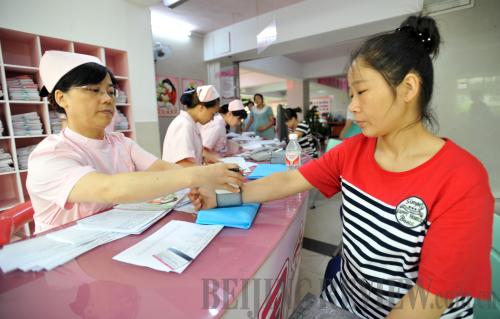|
 |
|
EARLY PREGNANCY CARE: At a maternal and child care center in Guilin, south China's Guangxi Zhuang Autonomous Region, an expectant mother receives a physical examination in July 2012 (LU BOAN) |
For instance, phenylketonuria (PKU) is a rare congenital defect. A person with this condition is unable to properly break down an amino acid called phenylalanine, found in milk, eggs and other protein-rich food. Patients usually have lighter skin, hair and eye color and may suffer from hyperactivity, rashes, seizure and even mental retardation. They should avoid consuming phenylalanine-rich food.
"Babies born with PKU are usually normal at birth. After three to four months, they will gradually exhibit delayed mental and mobile skills, and their urine and sweat will emit a musty odor," said Yu Song, Deputy Director of the Obstetrical Department of Beijing Obstetrics and Gynecology Hospital.
In addition to gene mutation and chromosomal disorders, birth defects can also result from environmental risk factors, or gene-environment interaction or other unknown reasons, Zheng said. These risk factors include infection from syphilis and HIV, and exposure to harmful substances such as X-ray radiation, lead, mercury, pesticides, drugs, alcohol and cigarette smoke.
"The problem of birth defects is related to environmental pollution, especially in eight major coal-mining zones," said An Huanxiao, Director of the Shanxi Provincial Commission of Population and Family Planning. Coal-rich Shanxi's rate of birth defects is among the highest in China.
Zheng said that the rise in birth defects in China is also associated with the increase in the percentage of women who give birth to their first child at older age. She said that currently, more than 10 percent of expectant mothers in metropolises such as Beijing and Shanghai are above 35 years old. Research shows that chromosomal disorders associated with birth defects such as Down's syndrome and cleft lip rise steeply after a woman reaches age 35.
In addition, nutrition deficiency, such as low intake of iodine and folic acid before and during pregnancy can also lead to birth defects, Zheng said. She said that folic acid deficiency can cause neural tube defects, and in north China's Shanxi Province and Inner Mongolia Autonomous Region where neural tube defects are prevalent, women's intake of folic acid is only one third of that of women in southern regions.
The abolishment of compulsory premarital physical examinations in China in 2003 has also been blamed for the rise in birth defect incidence. But Ren Aiguo, Director of Peking University's Institute of Reproductive and Child Health, said that the argument is not supported by data.
Lines of defense
In recent years, the government has launched programs to combat birth defects before, during and after pregnancy, says the Ministry of Health report.
The first defense line is preconception care, premarital physical examination, and consultation and care during early pregnancy, which are often provided for free.
Identifying and managing birth defect risks during pregnancy is the second part of the scheme. In 2011, 93.7 percent of pregnant women in China received prenatal screening for birth defects.
The third defense line is neonatal screening and treatment of birth defects. Since 2009, government subsidies for women giving birth in hospitals has been expanded to cover all rural areas. Between 2009 and 2011, 26 million pregnant rural women had received the subsidy, which significantly increased the percentage of hospital births in rural areas and raised the possibility for birth defects to be detected and treated in time.
The Ministry of Health also reported efforts specifically in rural areas. Between 2009 and 2011, the Central Government invested 320 million yuan ($51 million) to provide free folic acid supplements to 23.56 million rural women of child-bearing age. The initiative has significantly lowered the incidence of neural tube defects.
Since June 2010, a health insurance covering serious diseases among rural children such as congenital heart disease and leukemia has been piloted. As of the end of 2011, 26,536 children with congenital heart disease had been treated, and on average, the insurance paid 78 percent of the medical expenses.
Email us at: wanghairong@bjreview.com | 